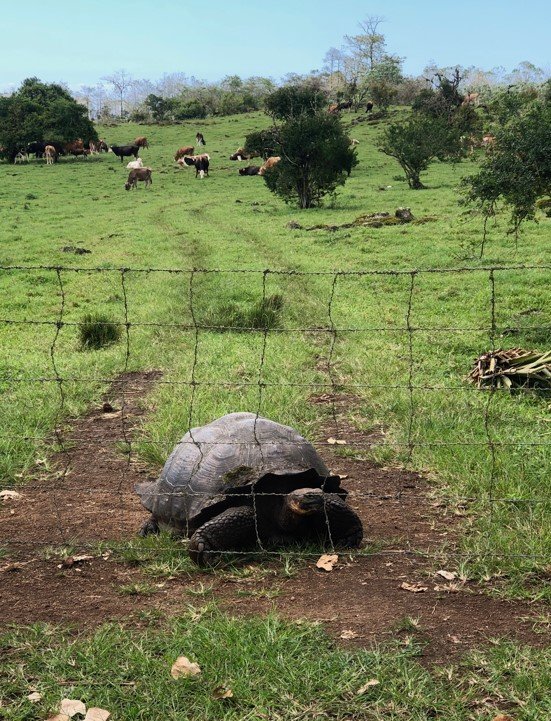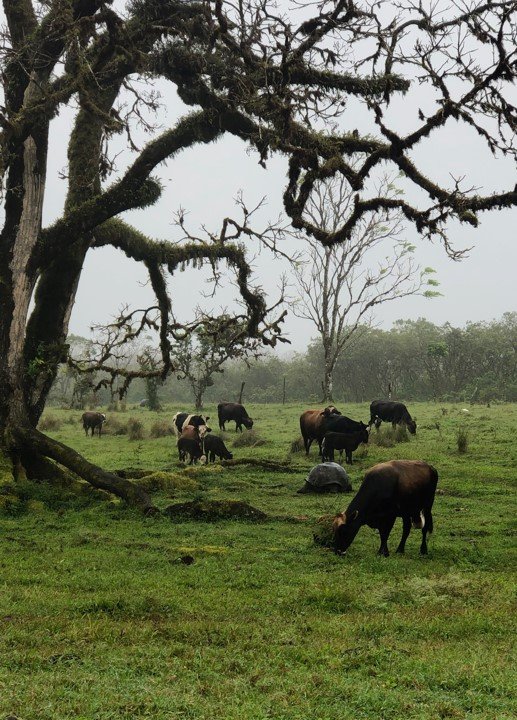Author: Kyana Pike is a collaborating scientist with CDF
An international team of researchers conducted a study on giant Galapagos tortoises and their interactions with human activities in the agricultural areas of Santa Cruz Island, where these emblematic animals go to feed and rest. The objective was to determine the density of tortoises (number of tortoises per hectare) in different farms in the highlands of Santa Cruz Island, to find out what habitat characteristics these species prefer, and how and why they use private farms. This information will allow us to manage and/or mitigate the threats that may arise from tortoises sharing farmland.
“Learning to share land with wildlife, without compromising productivity, or even increasing it, is essential to ensure sustainable human activities. Similarly, endangered wildlife, like giant tortoises, must be protected, due to the ecological role they play in the Galapagos socio-ecosystem”, mentions Lin Schwarzkopf, professor at James Cook University and co-author of the study.
On Santa Cruz Island there are two species of giant tortoise that are in danger of extinction, Chelonoidis porteri being the most abundant and also the one that has the greatest interactions with human activities such as agriculture, or tourism. On this island, giant tortoises migrate to the highlands every year to feed during the dry season, but today almost all of the humid highlands are used for agricultural purposes.

“The highlands are one of the most productive areas of Galapagos, which is why both tortoises and people need to make use of it. Each year, hundreds of tortoises use the agricultural area to forage for food and water during the dry season. Knowing their preferences on the farms can help us find ways to conserve the tortoises and at the same time advise the farmers and ranchers who share the land with these giants so that the farms can be more tortoise friendly, without compromising productivity,” explains Kyana Pike, lead author and Ph.D. student at James Cook University.
The results of this research show that the tortoises like short ground vegetation, without too many shrubs that could obstruct their path, and they are less likely to use abandoned farmland, as it is generally full of invasive species such as blackberry or cedrela. These lands are also problematic for farmers and for the conservation and management carried out by the Directorate of the Galapagos National Park. The farms where a greater number of tortoises are found today are those managed for tourism and livestock.
"One solution would be the rehabilitation of these abandoned agricultural areas so that they become productive again, which would benefit both people and tortoises," says Ainoa Nieto Claudín, a researcher at the Charles Darwin Foundation, Saint Louis Zoo, and co-author of the study.

“Research like this helps to figure out the best outcomes for wildlife and people using land. Often only small modifications can make land more wildlife-friendly, without compromising farm productivity,” adds Professor Lin Schwarzkopf.
This is a joint initiative between researchers from the Charles Darwin Foundation, James Cook University, Saint Louis Zoo, Saint Louis University, the Galapagos Conservation Trust, and the Australian National University, in collaboration with the Directorate of the Galapagos National Park and the support of the Houston Zoo. The results have been published in the journal Global Ecology and Conservation, which can be accessed through this link.
Kyana Pike is a collaborating scientist with the Charles Darwin Foundation (CDF), who conducted her PhD studies as part of the Galápagos Tortoise Movement Ecology Programme from 2018 to 2022 through James Cook University. CDF welcomes more than 100 visiting and collaborating scientists annually at its Research Station located in Puerto Ayora. For more information on this program contact cientificos@fcdarwin.org.ec.




